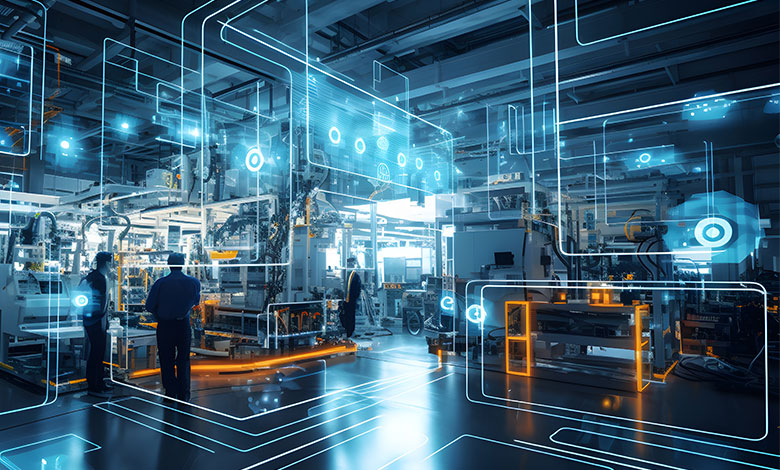For years, people have dreamed of automated factories and operations that can sustain themselves autonomously. While we haven’t quite reached that level, leading manufacturers have leapt toward that goal with the application of feasible and proven smart technologies in recent years. These new advances are revolutionizing manufacturing and can offer companies a competitive advantage.
The Senses of the Smart Factory
Industrial sensors have become a vital part of modern manufacturing. Not only can a wide variety of physical quantities such as temperature, pressure, flow, level, and location be monitored—the data can be used to automate all kinds of industrial processes.
Where maintenance personnel once had to go and manually check pressure and temperature to see if an issue was starting to appear, they can now perform other tasks while sensors keep an eye on these metrics and alert them as soon as there is a problem. This continuous monitoring allows them to address issues as quickly as possible, without wasting time periodically checking for problems.
Industrial sensors can be just as valuable for production as for maintenance. Temperature can drastically affect a manufacturing process, and monitoring these levels will ensure that products are manufactured to the correct specifications.
Industrial sensors are essential to many industrial processes, helping to improve efficiency, quality, and safety. For example, flow sensors measure the flow rate of raw materials and finished products to ensure that production lines are running efficiently. Temperature sensors monitor the temperature of furnaces and other equipment to ensure products are manufactured to the correct specifications. Level sensors monitor the level of liquids and solids in tanks and containers to ensure that there is enough material to keep the production process running and prevent overflow.
Smart cameras can “see” what is going on in the operation and, by using artificial intelligence, can analyze and interpret images. Thanks to advances in AI, anything you can train a human to watch for on a security camera monitor, you can teach a camera to do just as well. Successful implementation has already occurred for use cases in quality control, process optimization, and safety.
Contaminants in Pharmaceutical Manufacturing can be detected throughout the process, ensuring every pill is what you expect, when you take it. Issues in the manufacturing process can be spotted without the need for a person to conduct exhaustive studies. Most importantly, safety hazards such as spills and leaking gas can be detected, and the right people can be immediately notified.
The Brain of the Smart Factory
Industrial Internet of Things (IIoT) software platforms pull together data from industrial sensors, cameras, and controllers to paint a clear picture of the factory floor. The raw data can be processed at the edge to drive automation and then sent to up the stack to other systems or stakeholders, offering management real-time visibility into their operation. It also enables predictive maintenance to lower downtime, optimization of the production line by reducing waste, and the insight needed to develop new processes and products. When this data is processed at the edge, it does not have to travel to a central cloud server and back, which is especially important where low latency or autonomous operations are critical. Most operations have many legacy devices or tools that are older but can’t be connected to a modern network. Smart edge devices, specifically designed for manufacturing, can connect to any machine and ensure it becomes part of your IIoT stack leaving no device behind. If you’re curious about edge devices, check out my post.

The Limbs of the Smart Factory
Automated Mobile Robots and Automated Guided Vehicles (AMR/AGVs) are a type of smart technology that is becoming increasingly popular in the manufacturing industry. AMR/AGVs are used to automate a variety of tasks such as material handling, order fulfillment, and assembly. By automating repetitive tasks, AMR/AGVs can help to free up human workers to focus on more complex tasks such as machine repair and product development, which leads to increased efficiency and productivity. These robots have relatively low maintenance costs and may be less expensive than hiring additional staff for growing companies. AMR/AGVs can even help to improve safety in the workplace by automating tasks that are dangerous yet error prone due to repetition. One of their most valuable additions to a factory is the flexibility they bring. AMR/AGVs are able to reconfigure production lines quickly and easily, meaning workers won’t have nearly as much setup time. This can be helpful for manufacturers who have a high mix/low volume product offering or who need to be able to quickly adapt to changes in demand.
The Smart Factory Is Here—Let It Work for You
All of these factors described in a smart factory result in a business that is capable of producing finished goods with higher quality and safety standards, and greater efficiency. These technologies may be new, but they are far from unproven. Smart factories already exist, and the companies that implement them have seen tremendous benefits.
Since there are so many technologies to implement in an Industry 4.0 journey, many manufacturers have opted to simply worry about it down the line and focus on current issues. The truth is that investing in these technologies now will solve many of the challenges factories face today, and surely face down the line—like competitors with significantly lower costs.
Transforming your operation may seem daunting, but that’s why Connection has partners who handle every piece of the transition and have successfully managed these changes for customers. If you’re ready to get started with smart technologies, engage the Manufacturing Practice at Connection today. We’ll make sure you have everything you need to reap the benefits of a smart factory and see incredible results.

